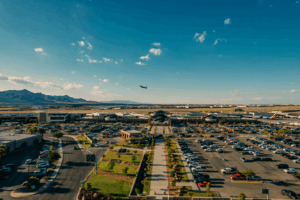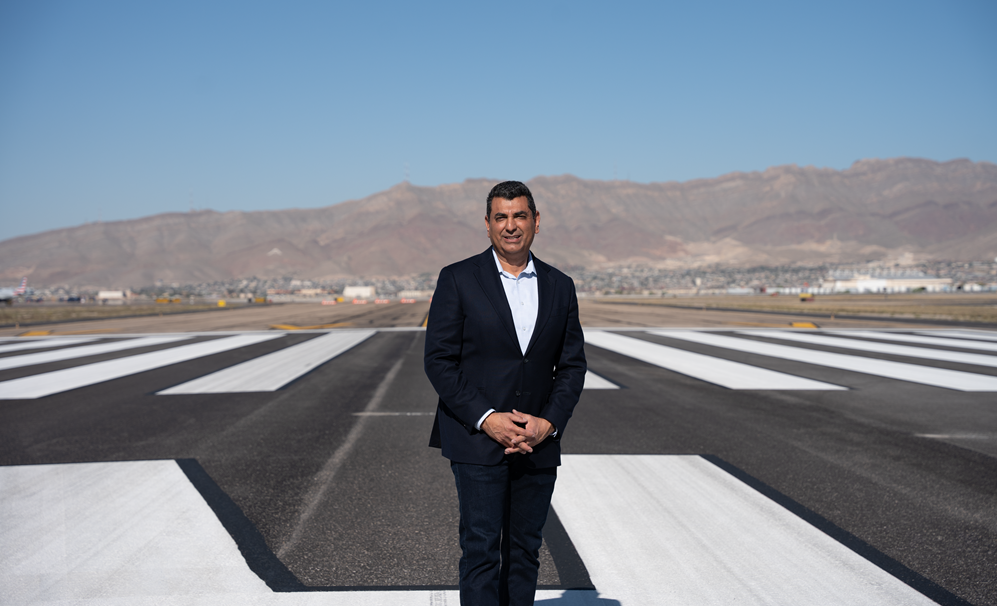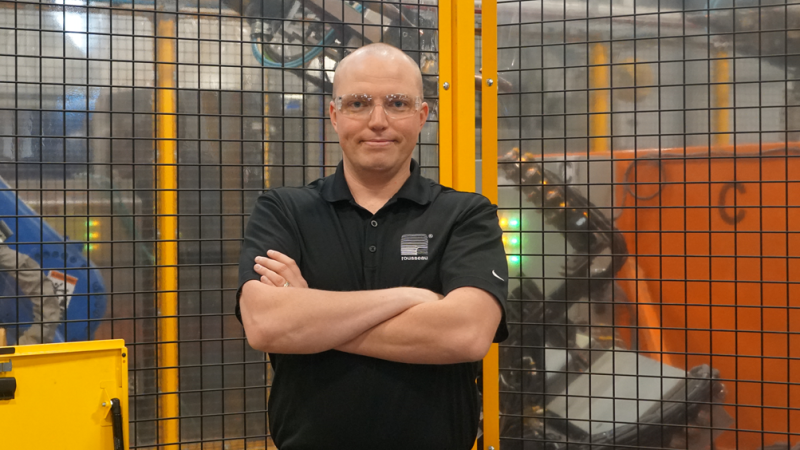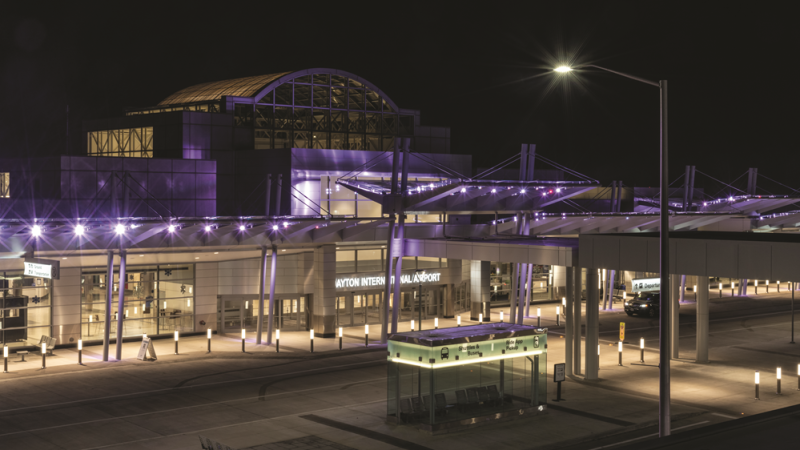El Paso International Airport enjoys a unique position, given its remarkable geographic location and strategic significance. The airport, nestled in El Paso, home to Fort Bliss and where West Texas, Southern New Mexico, and Northern Chihuahua connect, serves passengers and travellers from the United States and Mexico.
Tony Nevarez, Director of Aviation, explains that the airport, with its distinct time zone difference from the rest of Texas, is experiencing continuous growth, having recently surpassed four million passengers a year – a record-breaking milestone for 2024.
A seasoned aviation professional with over two decades of experience at the airport, Nevarez assumed his role in November 2024, and now oversees all aspects of the airport’s operations, ensuring it continues to serve as a vital economic engine driver for the region and a welcoming gateway for travellers.
He points out that El Paso International Airport will soon celebrate its 100th anniversary, a century of playing an important role in the history of both the United States and Mexico – from the Camino Real (Royal Road) which connected Mexico City and Santa Fe, to the Butterfield Trail, a major stagecoach route from St. Louis to San Francisco, El Paso has always been a major transport centre.
In 1928, El Paso’s first municipal airport officially commenced operations. During its nine decades of existence, El Paso International Airport has been at the forefront of the latest trends in aviation. In 1968, it became the nation’s first airport to have a 130-foot air traffic tower, and that tower in 2000 earned the distinction of being the country’s first to operate with a STARS radar system. El Paso also serves as the home of NASA’s Johnson Space Centre Forward Operating Location which was a training centre for astronauts during the shuttle missions.
Innovation and Economic Development
Exciting initiatives continue to take shape. One significant development is the establishment of the Innovation Factory, located within previously unleased cargo space on airport property. This facility marks the airport’s first step in bringing aerospace and defence manufacturing to El Paso.
In 2021, the City of El Paso joined the West Texas Aerospace and Defence Manufacturing Coalition, led by the University of Texas at El Paso (UTEP), to compete for the U.S. Economic Development Administration’s Build Back Better Challenge. The coalition successfully secured $40.1 million, with $25 million awarded directly to the City of El Paso to begin developing the 250-acre Advanced Manufacturing District on airport land.

“This investment represents a major milestone in our efforts to position El Paso as a hub for aerospace and defence innovation,” says Nevarez.
“This initiative aims to foster aerospace engineering and advanced manufacturing within the region. Historically, El Paso has faced economic challenges, with a lower per capita income compared to the rest of Texas and the United States. Many talented engineers have left the region due to limited career opportunities.”
“We transformed previously unused airport space into a dedicated hub for aerospace and defence manufacturing start-ups, providing them with the opportunity to establish and grow their operations. The conversion of previously unused airport space into a space for aerospace and defence manufacturing start-ups represents a significant step toward sustainable economic growth.”
“This initiative is closely tied to the Advanced Manufacturing District, a 250-acre development on airport property designed to centralize aerospace, defence, and other advanced manufacturing activities in one strategic location.”
Nevarez affirms that the airport has always been aware of its role in the local community. “El Paso International Airport is one of the city’s largest employers, directly supporting over 4,000 jobs. The airport also plays a crucial role in community engagement by reaching out to local schools, especially elementary and junior high students, to spark interest in aviation careers.”
“Our outreach programs, involving drone technology and remote piloting, introduce students to the future of aviation, including unmanned flight, advanced air mobility, and air taxis. We also support UTEP’s Upward Bound program, which assists first-generation college students in pursuing higher education.”
Smart Airport Solutions
Nevarez affirms that sustainability is a key focus for El Paso International Airport. Two major solar energy projects are set to launch – the installation of solar panels on top of the airport’s consolidated rental car facility, and the installation of solar panels in the premium reserved parking lot.
“We’re always looking to bring in new ideas to further improve our sustainability credentials. In addition to utilizing solar energy, we have transitioned to LED lighting throughout the Terminal reducing the terminal’s lighting energy consumption by 20%. We are also exploring self-driving electric shuttles as part of a pilot program.”
To optimize parking facilities, the airport is deploying AI technology that will provide real-time information on available parking spaces, helping travellers plan their parking choices before arriving at the airport.
Despite staffing challenges – a common problem across all industries – the airport is set to progress with modernization and expansion. Just recently, two significant grants totalling $27.7 million were obtained from the U.S. Federal Aviation Administration (FAA) to fund vital infrastructure improvements that will strengthen the airport’s capabilities, ensuring long-term benefits for both passengers and operators.
“The first significant upcoming project involves redesigning a complex five-node intersection on the airfield. This intersection, which has multiple taxiways and runways converging, has been identified as a potential hazard for pilots unfamiliar with the airport, and the new design will enhance both safety and efficiency,” says Nevarez. The airport was also awarded a grant to replace a portion of the aging and failing terminal ceiling that protects critical areas of operation.”
Future Ambitions
Speaking about plans for the future, Nevarez affirms that expanding airline services remains a priority for El Paso International Airport. While the airport has strong connections to major hubs such as Dallas and Atlanta, securing a direct flight to Washington, D.C. remains a challenge.

“Given El Paso’s location on the border and the presence of multiple law enforcement agencies and military installations, a direct route to the nation’s capital is in high demand. This is something that we continue to pursue.”
When asked about his top priorities as the new Airport Director, he say: “Even though I recently stepped into this role, the airport isn’t new to me. I was born in El Paso and have spent 21 years here, working in operations and security. Right now, my focus is on learning as much as I can from the team across different departments. One of my biggest goals is to strengthen collaboration—because when we work together seamlessly, we can accomplish so much more.”
“Another key goal is to maximize the use of the airport’s 7,000 acres of land, of which 2,000 acres remain undeveloped. So together with my team, we will continue developing that land and developing the opportunities that go with that. The overall objective is to ensure that El Paso International Airport continues to be a driving force for economic development, education, and technological advancement.”







